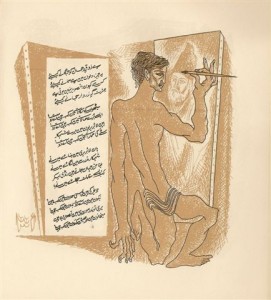About Poetry
 Sadequain belonged to the fertile small town of Amroha in Uttar Pradesh, India, which had produced a number of eminent scholars, poets, and many other prominent luminaries in the past. It was his great grand father, under whose tutelage Mir Taqi Mir – considered the father of Urdu poetry – developed his poetic skills at an early age. Mir Anis, the preeminent religious poet from Lucknow, was the understudy of one of his ancestors too. He witnessed his elders delve in poetry, calligraphy, and even classical music to the extent it complimented marsia khwani – the revered practice to commemorate the martyrdom of Imam Hussain in Karbala. An accomplished poet of merit himself, Sadequain studied since childhood the eloquent and picturesque poetic renditions of supreme sacrifice of Karbala, penned by Mir Anis and Mirza Dabeer. Sadequain himself composed conventional marsias at an early age, and penned one in memoriam of his younger sister’s death in 1946, when he was in his teens. The soul of marsia is inspired by the ultimate sacrifice and human suffering thus evoking empathy for the righteous and the deprived – the common victims of society. He grew up a traditionalist, with rich cultural values, solid grounding in fine arts, and cultivated a sense of appreciation for history’s significance. By the time he was 18 he had composed over 400 pieces of poetry and sketched scores of drawings.
Sadequain belonged to the fertile small town of Amroha in Uttar Pradesh, India, which had produced a number of eminent scholars, poets, and many other prominent luminaries in the past. It was his great grand father, under whose tutelage Mir Taqi Mir – considered the father of Urdu poetry – developed his poetic skills at an early age. Mir Anis, the preeminent religious poet from Lucknow, was the understudy of one of his ancestors too. He witnessed his elders delve in poetry, calligraphy, and even classical music to the extent it complimented marsia khwani – the revered practice to commemorate the martyrdom of Imam Hussain in Karbala. An accomplished poet of merit himself, Sadequain studied since childhood the eloquent and picturesque poetic renditions of supreme sacrifice of Karbala, penned by Mir Anis and Mirza Dabeer. Sadequain himself composed conventional marsias at an early age, and penned one in memoriam of his younger sister’s death in 1946, when he was in his teens. The soul of marsia is inspired by the ultimate sacrifice and human suffering thus evoking empathy for the righteous and the deprived – the common victims of society. He grew up a traditionalist, with rich cultural values, solid grounding in fine arts, and cultivated a sense of appreciation for history’s significance. By the time he was 18 he had composed over 400 pieces of poetry and sketched scores of drawings.
Sadequain was blessed with an exemplary talent in all three distinct traits in the arts and literature; he was a prime painter, impeccable calligrapher, and an accomplished poet. He artfully weaved these three genres together and embellished them with his deep thinking philosophical streak. A unique and rare combination, perhaps one and only, which brought together, in his own words, the talents of poet Omar Khayyam, calligrapher Yaqoot, and painter Mani. Few in history have distinguished themselves in mastering multiple disciplines like Omar Khayyam did as an accomplished poet and a mathematician. Humans are endowed with the gift of reason and have the power of expression. But all who can write cannot be termed writers and all who can paint cannot be classified as painters. Sadequain mastered the two domains of writing and painting, and bridged them in a seamless manner of preeminence; a manner not witnessed previously in the region or since. His appreciation of classical poetry later manifested in his illustrations and interpretations of the poetry of Ghalib, Iqbal and Faiz Ahmed Faiz.
Starting in the last quarter of 1969, and through the first few months in 1970, Sadequain concentrated on composing, inscribing, and illustrating hundreds of rubaiyyat, arguably a composite creation by a single person unparalleled in the realm of art and literature. In the prologue of his collection of rubaiyyat, Sadequain compared his accomplishment as an audacious confluence of global talent, the rubaiyyat of poet Omar Khayyam, transcription by the renowned calligrapher Yaqoot and illustration by the legendary painter Mani. “That of course would produce a magnificent piece of work”, he stated, “however, no matter how grand, it would still be a group show.” Sadequain reached for the ultimate one-man show, and produced a masterpiece collection of rubaiyyat, which was adjudged for first prize by the Literary Society of Pakistan. Sadequain privately published 4 books of rubaiyyat; Rubaiyyat-e-Sadequain Naqqash, Rubaiyyat-e-Sadequain Khattat, Rubaiyyat-e-Sadequaini, and Juzw-e-Bosida. The collection titled Rubaiyyat-e-Sadequain Naqqash was an illustrated version with over two hundred drawings. The collection of rubaiyyat titled Juzw-e-Bosida, dating back to his poetry of teen years, was printed privately in the 1980s, but the drawings of his teen years were lost or destroyed.
